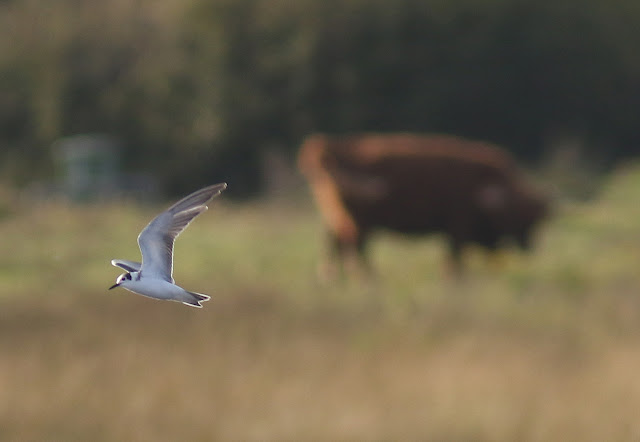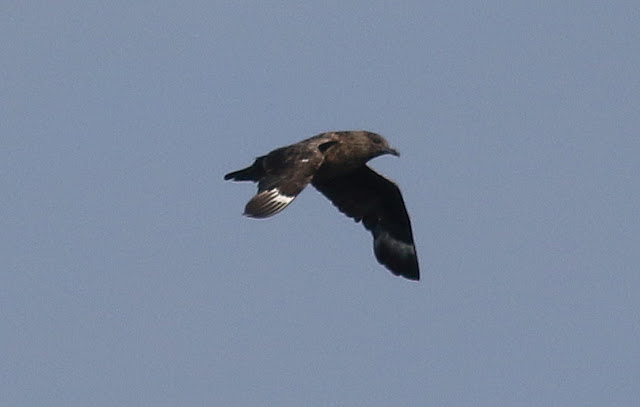Day 1 Newhaven to Dieppe
A calm sunny crossing, perfect for cetacean watching but didn't see a single bit of blubber. A few birds included 10+ European Storm Petrel, 4 Great Skua, 5 Kittiwake, 100+ Gannet, 1 Fulmar, 10 Sandwich Tern, 1 Common Tern and 1 auk sp. A few passerines were moving over the boat including 8 Meadow Pipit, 1 alba Wagtail, 5 House Martin and 6 Swallow. 2 Wheatears were at Newhaven harbour and a Black Redstart was at Dieppe.
An Angle Shades moth was on the ferry.
Adult Gannet
Third-calender year Gannet
European Storm Petrels
Newhaven
Day 2 Parc de MarquenterreLiterally the most annoying bird hides in the world with tiny mixed shapes to peer through. Other than that an excellent reserve and even better mussels for lunch in the restaurant.
Some nice birds including 40+ Spoonbill, 8 Cattle Egret, 1 Great White Egret, 4 Spotted Redshank, 6 Greenshank, 20+ Redshank, 80+ Black-tailed Godwit, 4 Ruff, 1 Green Sandpiper, 1 Common Sandpiper, 200+ Lapwing, 250+ Shoveler, 50+ Teal, 1 Pintail and 2 Kingfisher.
Some roadside pools and the saltmarsh of the Baie were also birdy with 8 Black Tern and an Arctic Tern over one pool.
Tawny Owl in the campsite at night.
Only a couple of moths in the cold evenings- Dusky Thorn and a couple of Sqaure-spot Rustic.
Adult and immature Spoonbill
Adults and juvenile Spoonbill
Spotted Redshank and Common Redshanks
Juvenile Black Terns
Cattle Egret
Wheatear
Grey Partridge (adult top and juveniles above)
and this Cricket sp.
Had this hybrid presumed Teal x Gadwall? at Le Crotoy
While on the subject of dodgy waterfowl, I thought I'd picked up White-fronted Goose flying over on the nocturnal sound recording but the sounds were so bizarre and clearly not flying over that I eventually concluded they must be some captive geese somewhere. Mystery solved this morning when I came across the campsite wildfowl collection that included Greater and Lesser Whitefronts, Teals, Mallard and Tufted Duck. Was interesting to see the variation in the orbital ring from a Lesser White-fronted Goose (with it's diagnostic prominent yellow orbital ring) to differences in the Greater White-fronts (below- showing one bird with a pale yellow orbital ring to one with barely no orbital ring). Reminded me of THIS- so not sure if there is hybridisation going on or whether re: Collins guide variation in the orbital ring within Russian White-fronts (which these captive birds were presumably as pinks bills).
In-distinctive orbital ring
Even less distinct orbital ring
L'able d'ault
Day 3 L'hable D'Ault and Baie de Somme area
Today we had lunch at Cayeux-sur-Mer and then drove along the track by L'able d'ault (which looks like a hunting reserve). Great White and Cattle Egrets, Black Swan, Sandwich and Common Tern, Black-necked Grebe, Mediterranean Gull and quite a few passerine migrants including 10+ Wheatear, 2 Whinchat, 5 Stonechat, 8 White Wagtail, 4 Yellow Wagtail and 10+ Mipit. A few Chaffinches were moving over during the day.
Had a drive north through forest villages and small farm holdings to Quend Plage and the early evening checked out the pools near Le Crotoy- only 2 Black Tern left. In the evening looked out over the Baie de Somme from Le Crotoy where there were Spoonbill and a large gull roost.
Juvenile Black Terns
Cattle Egret
Wheatear
Grey Partridge (adult top and juveniles above)
Day 4 Duffering around the camp site, lunch at Le Crotoy and dessert at Quend Plage
A day of complete 'shoot-me-if-I-ever' stuff with a walk round the campsite with the baby in the morning and the rest of the day doing tourist stuff. Secretly loved it!
Despite the appalling behaviour still managed to get Black Woodpecker (calling), a possible Middle Spot, Tawny Owl, Crested Tit, good numbers of Chiffchaff and fly over Hawfinch at the campsite.
The moth trap was still quiet but better than other nights with a male Four-spotted Footman, Sallow, Dusky Thorn, Coronet, Tachystola.acroxantha, Agonopterix purpurea, Mint moth, Lesser Yellow Underwing and a Vestal in the day.
Male Four-spotted Footman with distinctive dark shoulder bar
Sallowand this Cricket sp.
Had this hybrid presumed Teal x Gadwall? at Le Crotoy
While on the subject of dodgy waterfowl, I thought I'd picked up White-fronted Goose flying over on the nocturnal sound recording but the sounds were so bizarre and clearly not flying over that I eventually concluded they must be some captive geese somewhere. Mystery solved this morning when I came across the campsite wildfowl collection that included Greater and Lesser Whitefronts, Teals, Mallard and Tufted Duck. Was interesting to see the variation in the orbital ring from a Lesser White-fronted Goose (with it's diagnostic prominent yellow orbital ring) to differences in the Greater White-fronts (below- showing one bird with a pale yellow orbital ring to one with barely no orbital ring). Reminded me of THIS- so not sure if there is hybridisation going on or whether re: Collins guide variation in the orbital ring within Russian White-fronts (which these captive birds were presumably as pinks bills).
In-distinctive orbital ring
Even less distinct orbital ring
Day 5 Dieppe to Newhaven
A few birds on the return ferry crossing included 15+ Great Skua, 1 Arctic Skua, 11 Common Scoter, 3 Fulmar, 1 Kittiwake, 50+ Gannet and a steady trickle of Swallows moving across the Channel.
A few birds on the return ferry crossing included 15+ Great Skua, 1 Arctic Skua, 11 Common Scoter, 3 Fulmar, 1 Kittiwake, 50+ Gannet and a steady trickle of Swallows moving across the Channel.
Adult winter Arctic Skua- a younger bird would have barred underwing coverts. An all dark underwing is diagnostic of adults.
Great Skua over the boat- good numbers on this crossing. This individual is not a juvenile (which would not be moulting). This moulting bird is 2 cy or older. Just visible are the brown-gold markings on the scapulars which are diagnostic of Great Skua from South Polar (all age classes would be moulting in the North Atlantic in September).
Common Scoter
Scenery Shots
Baie de Somme from Le Crotoy
The Green spots mark the birding spots we found
People Pics
Wouldn't be France without this. Must start listing my french cheeses too.
Maps
Baie de Somme is very close to Britain- just an hour north off Dieppe and a little further south of Calais harbour. Took us 1.15hr to get to Newhaven and then a pleasant 4 hour crossing. What a difference the Channel makes- Black Woodpeckers, Crested Tit, Spoonbills, Great White and Cattle Egrets etc and the Capitalists are in their place here too!The Green spots mark the birding spots we found
Videos
Natterjack Toad (at the campsite facility block )
The last word from Jacob
































No comments:
Post a Comment